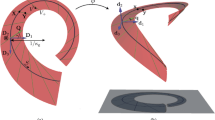Abstract
Cluster–rod structure were designed, which are comprised of tetrahedral atoms with a typical torsion angle of ~38° at interatomic bonds. These structures correspond to a muscle tissue and clathrin lattice by their metrics and topology and can be formed by bound water in these systems. It is shown that the considered rod structures, which are fragments of bound water structures, can also be involved in nondissipative energy transmission as elastic energy storing structures. The estimated length of the bound water rod structure required to absorb the energy of decomposition of an ATP molecule into ADP and a phosphate group is comparable with myosin head sizes and its step along an actin filament. A mechanism of cooperative transition of the rod structure to a fragment of the ice Ih structure was demonstrated. This transition is accompanied by nondissipative release of stored energy.
Similar content being viewed by others
Abbreviations
- TYMV:
-
turnip yellow mosaic virus.
References
N. A. Bulienkov, Sov. Phys. Crystallogr. 33 (2), 250 (1988).
N. A. Bulienkov, Sov. Phys. Crystallogr. 35 (1), 88 (1990).
N. A. Bulienkov, Sov. Phys. Crystallogr. 35 (1), 92 (1990).
N. A. Bulienkov, Biofizika 36 (2), 181 (1991).
N. A. Bulienkov, in Fields Institute Monographs, Vol. 10: Quasicrystals and Discrete Geometry, Ed. by J. Patera (American Mathematical Society, Providence, RI, 1998), pp. 67–134.
N. A. Bulienkov, Biophysics (Moscow) 50 (5), 811 (2005).
N. A. Bulienkov, Crystallogr. Rep. 56 (4), 680 (2011).
N. A. Bulienkov and E. A. Zheligovskaya, Struct. Chem. 28 (1), 75 (2017).
N. A. Bulienkov and E. A. Zheligovskaya, Russ. J. Phys. Chem. 80 (10), 1584 (2006).
V. I. Lobyshev, A. B. Solovei, and N. A. Bulienkov, Biophysics (Moscow) 48 (6), 932 (2003).
B. K. Vainstein, V. M. Fridkin, and V. L. Indenbom, Modern Crystallography, Vol. 2: Crystal Structure (Nauka, Moscow, 1979) [in Russian].
N. A. Bulienkov and E. A. Zheligovskaya, J. Struct. Chem. 55 (7), 1215 (2014).
Ch. de Duve, La cellule vivante, une visite guidée (Pour le Science, 1987; Mir, Moscow, 1987).
J. R. Bendall, Muscles, Molecules, and Movement (Heinemann Educational Books Ltd, London, 1969; Mir, Moscow, 1970).
A. Fotin, Y. Cheng, N. Grigorieff, et al., Nature 432, 649 (2004).
N. Maeno, The Science of Ice (Hokkaido Univ. Press, Sapporo, 1981; Mir, Moscow, 1988).
A. Szent-Györgyi, Bioenergetics (Academic Press, New York, 1957; Gos. Izd. Fiz.-Mat. Lit., Moscow, 1960).
L. A. Blumenfeld, Problems in Biological Physics (Nauka, Moscow, 1977) [in Russian].
Author information
Authors and Affiliations
Corresponding author
Additional information
Original Russian Text © E.A. Zheligovskaya, N.A. Bulienkov, 2017, published in Biofizika, 2017, Vol. 62, No. 5, pp. 837–845.
Rights and permissions
About this article
Cite this article
Zheligovskaya, E.A., Bulienkov, N.A. Rod structures of bound water: a possible role in self-organization of biological systems and nondissipative energy transmission. BIOPHYSICS 62, 683–690 (2017). https://doi.org/10.1134/S0006350917050256
Received:
Published:
Issue Date:
DOI: https://doi.org/10.1134/S0006350917050256




